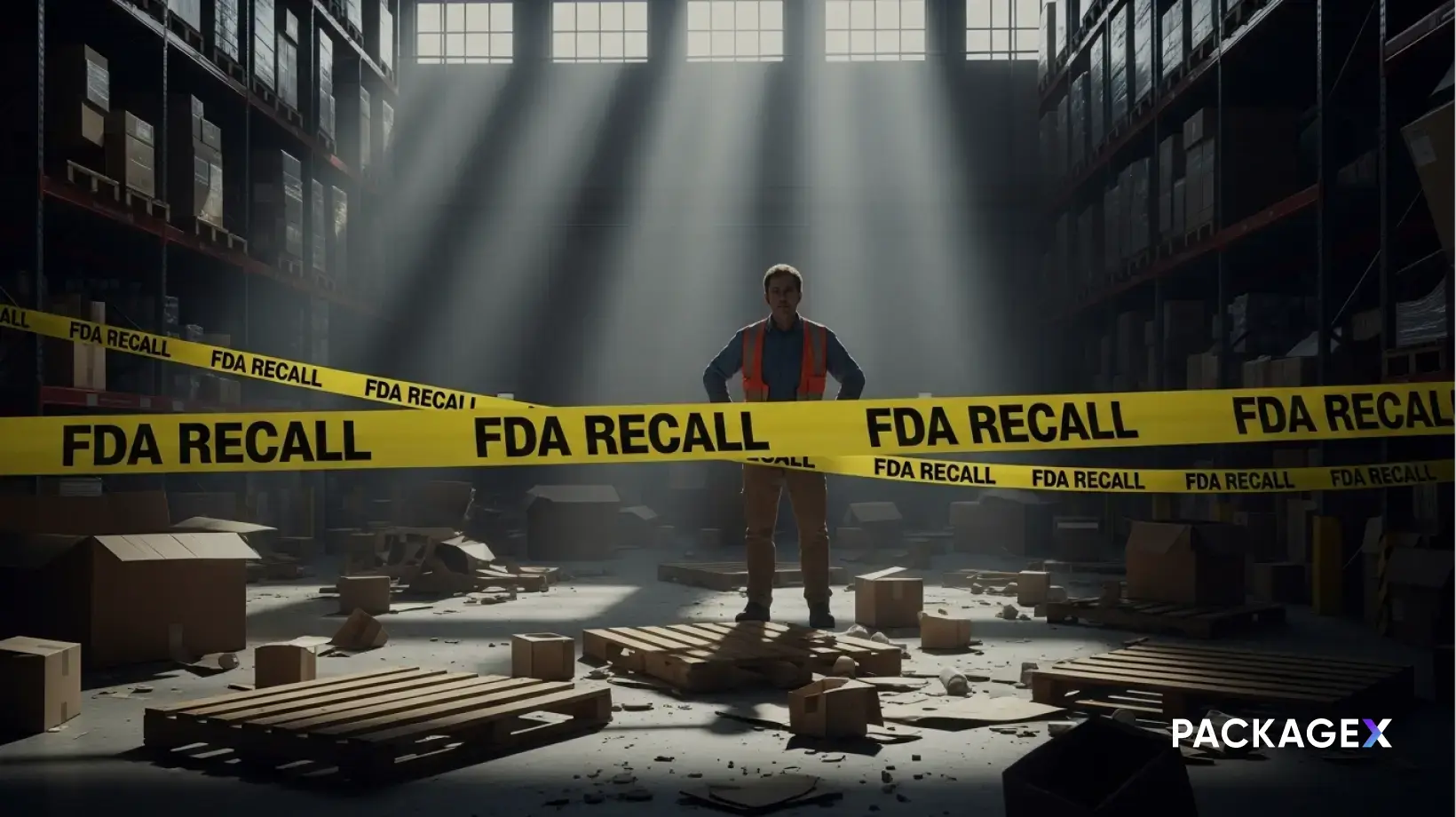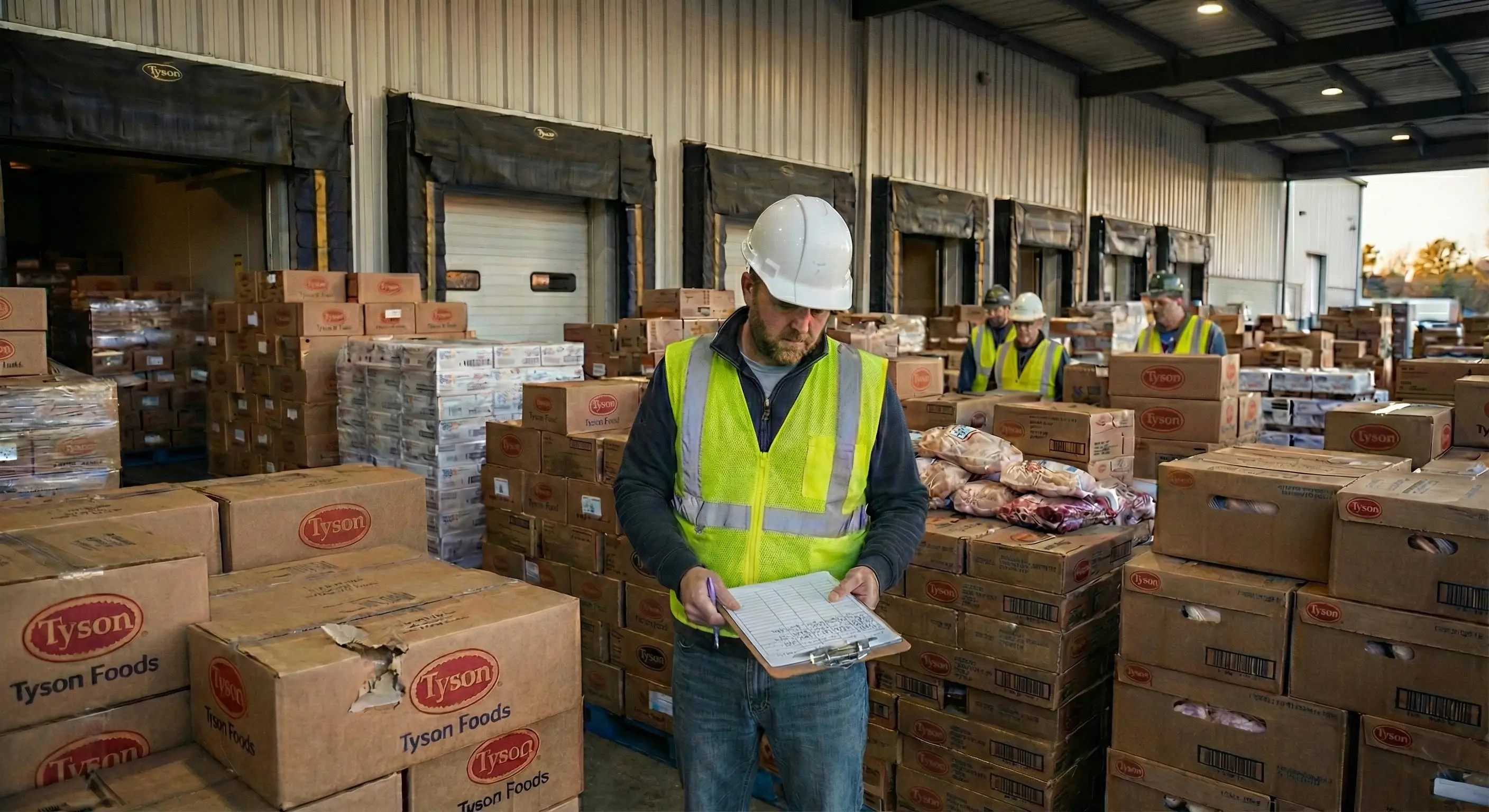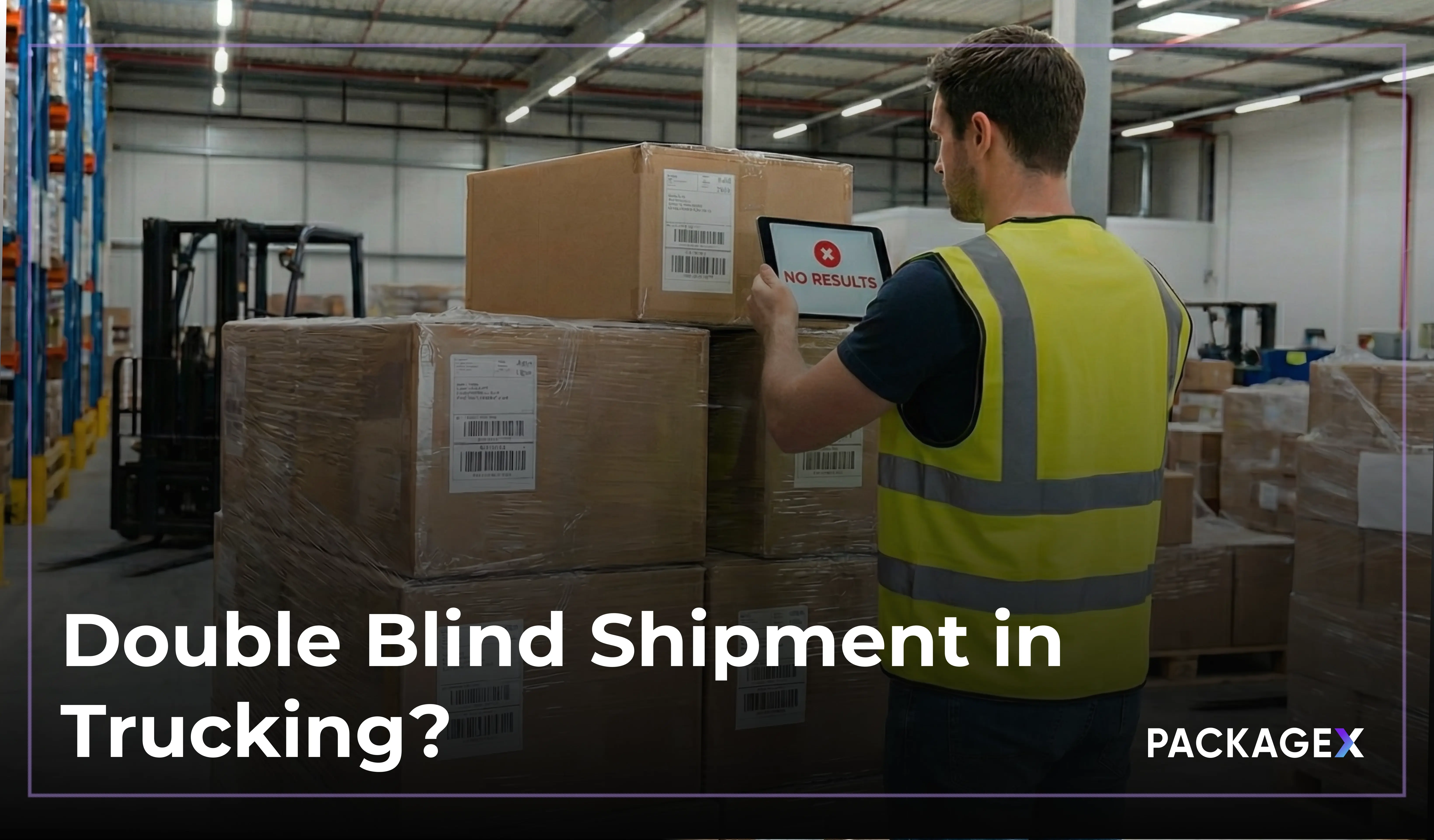A bad ingredient killed people.
The FDA showed up. They wanted proof the contaminated ingredient was limited to specific lots. They wanted evidence it only went into certain batches.
The company couldn't prove it.
Their ERP system was too weak. It couldn't demonstrate lot-level traceability. So the FDA forced them to destroy everything—$30 million in inventory. Gone.
This isn't fiction. It's a real story from a production planning professional on Reddit, sharing what happens when your inventory system fails at the worst possible moment.
And it's not an isolated incident.
Across manufacturing facilities, 3PL warehouses, and fulfillment centers, inventory disasters happen every single day. Most don't make headlines. Most don't cost $30 million. But they're costing 3PLs thousands in write-offs, labor hours, and client trust—one miscount at a time.
Always the same. Manual processes. Poor visibility. Trust without verification.
And there's a question every 3PL operator should be asking: Could this happen to us?
When You Can't Prove What You Have
Here's what the FDA disaster really reveals—the risk lurking in every 3PL warehouse: traceability.
It's not enough to know you have inventory. You need to prove where it came from, when it arrived, which lot it belongs to, and where it went. When a regulatory agency or major client shows up asking questions, "we think it's fine" doesn't cut it.
But here's the problem most 3PLs face: their systems aren't built for that level of proof.
In the FDA case, the company's ERP couldn't demonstrate the contaminated ingredient was isolated. They probably knew it was isolated. Their warehouse team probably had spreadsheets showing which pallets came from which vendor. But they couldn't prove it in a way that satisfied regulators.
So everything had to go.
This same gap shows up in 3PL operations constantly. Just with lower stakes.
A client questions an inventory count. Your system shows 50 units. The client's records show 75. You dig into receiving logs and find a shipment from three weeks ago that was entered manually—someone typed "5" instead of "25."
Now you're on the phone with the client explaining a phantom 20-unit shortage. Your team's doing a physical recount. Your warehouse manager's pulling camera footage trying to figure out what happened. You're burning hours trying to reconstruct a chain of custody that should've been automatic.
The real cost isn't just the missing inventory. It's the client trust that erodes every time the numbers don't match.
The Guy Who Couldn't Stop Deleting Things
Sometimes disasters aren't one-time events. Sometimes they're people.
One Reddit user shared a story about a 60-year-old production planner—we'll call him "The Guy"—who thought deleting rows in Excel discontinued products in the system.
It didn't.
What actually happened: The Guy was manually forcing production targets in the ERP for months, overriding the system's automated calculations. When he deleted a product row in his Excel report, he assumed it stopped production.
The system kept running. It kept manufacturing discontinued products for months because The Guy had hard-coded production targets that nobody else knew about.
This happened three times.
The company didn't fire him—he was too close to retirement, and the optics were bad. Instead, they stripped his access, gave him low-volume products to manage, and locked his Excel reports to view-only.
The damage? Probably more than he earned in salary over his entire career.
The 3PL Version of This Story
You might be thinking: "We don't have a Guy like that."
But here's the uncomfortable truth—most 3PL warehouses do.
It's the warehouse associate who's been there 10 years and has a "system" for tracking inventory that lives entirely in his head. It's the receiving clerk who shortcuts the process because "it's faster this way." It's the team that's still using a binder with handwritten receiving logs because "the scanner's too slow."
And when those people leave, retire, or get sick, the institutional knowledge walks out the door with them.
One 3PL operator we talked to—Jim—described his current warehouse management system as one that "hallucinates." His WMS would tell the team to pick items that weren't even in the warehouse. It'd send pick lists for products that hadn't been ordered.
Jim's team couldn't trust the system. So they built workarounds. Manual checks. Excel logs. Verification steps that shouldn't be necessary if the system worked.
Human error compounding system error. The worst possible combination.
40 Pallets of Pumpkins to a Caribbean Island
Not all inventory disasters are about traceability or system failures. Sometimes it's just a really, really bad order.
A warehouse manager ordered 40 pallets of pumpkins to a Caribbean island when he meant to order 40 pumpkins.
The pumpkins arrived by boat. All 40 pallets. In Caribbean heat.
There was no storage. No plan. The pumpkins started rotting almost immediately.
They buried them on a beach.
The Real Problem: No Verification
This story's funny because it's absurd. But it exposes a critical gap in most 3PL operations: order verification.
How many steps are there between "placing an order" and "realizing the order's wrong"? In this case, zero.
Nobody reviewed the PO. Nobody flagged that 40 pallets of pumpkins to a Caribbean island seemed unusual. Nobody stopped to ask, "Wait, do we actually need 40 pallets?"
The same thing happens in 3PLs every day. Just at smaller scales.
A client orders 500 units. The vendor ships 5,000. Your team receives all 5,000 because the packing slip says 5,000. Three weeks later, the client gets an invoice for 5,000 units and calls you asking why their storage fees are 10x what they expected.
Now you're stuck mediating between the client and vendor, trying to figure out who authorized the overage and who's paying for the return.
One 3PL operator—Eduard—described this exact problem. His team would receive shipments without comparing them against expected quantities. When they finally did a physical count, they'd discover mismatches everywhere. Sometimes they'd be short. Sometimes they'd have extra. And because everything was manual, nobody knew when the discrepancy happened.
Eduard admitted: "Sometimes we think something's in one box. It's not there. You have to start moving stuff around to find the item. Sometimes we can't find it—we just buy a new one. Then later we find the original. Now we're buying double."
That's inventory chaos in slow motion.
The Non-GMO Label Disaster That Cost 3 Jobs
Here's a disaster that combined poor planning, poor communication, and poor visibility into one expensive mess.
A major snack food company was transitioning from standard packaging to "Non-GMO" labeled packaging. The cutover date was January 1st.
But nobody told procurement to stop ordering the old packaging.
The result? Hundreds of pallets of old-label inventory showed up in the months leading up to the cutover. By the time January 1st rolled around, the warehouse was full of unusable product.
The 3PL co-packer had to request a certificate of destruction. They needed executive sign-off to destroy hundreds of pallets of perfectly good product—just because the label was wrong.
The brand's team tried to blame the 3PL for "not communicating." But the warehouse manager had the receipts. Months of emails trying to flag the issue. Warnings that they were receiving too much old inventory. Requests to slow down shipments.
Nobody listened.
Three people from the brand lost their jobs. The warehouse manager got an award for handling the situation without losing the client.
Why This Happens in 3PL Operations
This story reveals the most common breakdown in 3PL operations: no visibility into inbound shipments.
The warehouse knew product was coming. But they didn't know how much until it showed up. And by then? Too late.
About 80% of shipments arrive at 3PL warehouses without an advance shipping notice (ASN). That means 80% of the time, warehouse teams are receiving blind. They don't know what's coming. They don't know how much. They don't know when.
So they can't plan. Can't flag overages. Can't stop a disaster before it happens.
Chris, a CTO at a growing 3PL, described this exact problem: "I need to know that the store's expecting a second receipt. Otherwise my finance team's going to close the purchase order. I need a checkbox—don't close it yet, we're still waiting on the other half."
Without that visibility, finance closes POs prematurely. Warehouse teams receive shipments that "shouldn't exist" in the system. Inventory counts drift further and further from reality.
And by the time someone notices, you're staring at hundreds of pallets of unusable inventory.
The Pattern Behind Every Disaster
Look at these stories—$30M in destroyed product, a production planner forcing ghost SKUs, 40 pallets of rotting pumpkins, and a Non-GMO labeling disaster. They all share the same root causes.
1. Manual Data Entry Creates Compounding Errors
Every manual touchpoint's an opportunity for error. Type a "5" instead of "25", that 20-unit shortage compounds across every downstream process. Inventory counts are wrong. Pick lists are wrong. Client invoices are wrong.
Jim's experience with his WMS that "hallucinates" is a perfect example. When the system doesn't capture accurate data at receiving, everything downstream becomes unreliable. The team stops trusting the system. So they build manual workarounds. Which introduce more errors.
Research shows manual receiving processes operate at 67-85% accuracy. That means 15-33% of the time, something's wrong. A miscount. A wrong SKU. A damaged item not flagged.
And those errors don't stay isolated. They cascade.
2. No Real-Time Visibility = Decisions on Bad Data
Eduard's team would do physical inventory counts once a week. Which meant for six days, they were operating on stale data.
He described the problem perfectly: "Sometimes the inventory's zero in the system. But this week, we have a job. So they took some stuff from inventory. By the time we check, the inventory count's never reflected."
Translation: His team was making fulfillment decisions based on data that was already wrong.
Same thing happened with the Non-GMO disaster. The warehouse knew they were getting too much old inventory. But nobody had real-time inventory visibility into how much until it was already sitting on pallets in the warehouse.
By then, the decision was made for them.
3. Trust Without Verification = Disasters Waiting to Happen
The pumpkin story's funny because it's absurd. But it reveals a critical truth: most 3PLs operate on trust.
Trust that the vendor packed the right quantity. Trust that the packing slip's accurate. Trust that the carrier delivered everything.
But trust breaks down.
One 3PL operator described receiving a container that was supposed to have 2,000 units. When they counted, only 800.
Another described shipments arriving with "shortages, overages, and damages" because there was no verification step between the packing slip and what actually showed up.
In the FDA disaster, the company trusted their ERP had the right data. They trusted their receiving logs were accurate. But when the FDA asked for proof, trust wasn't enough.
4. Shadow Inventory Costs You Twice
Eduard admitted his team would sometimes buy duplicate items because they couldn't find the original. Then later, they'd discover the original item buried in a different box.
This is shadow inventory—inventory you paid for but can't use because you don't know where it is.
It's the 3PL equivalent of the Excel Guy forcing ghost production runs. You're spending money on inventory you don't need because your system can't tell you what you already have.
And when clients ask, "Where's my stock?"—you're stuck doing a physical search to prove it exists.
What Saves Your Margins When Everything Goes Wrong
The 3PLs that avoid these disasters aren't lucky. They're deliberate.
They've eliminated the manual failure points. They've built visibility into every step. They've replaced trust with verification.
Here's how.
1. Automate Receiving to Eliminate Human Error
The single biggest source of inventory errors, the receiving dock.
Manual data entry. Handwritten packing slips. Associates typing SKU numbers from memory. Every one of these touchpoints introduces error.
Automated receiving eliminates that risk. Instead of manually typing data, warehouse teams scan labels, barcodes, or BOLs. The system captures everything—tracking numbers, quantities, SKUs, vendor info—and validates it against expected shipments in real-time.
If something doesn't match? The system flags it immediately. Not six days later during a physical count. Not three weeks later when the client complains. Right now.
Jim's WMS problem—where the system would "hallucinate" pick lists—could've been prevented with better receiving data. If the system knows exactly what came in, it can't tell you to pick items that don't exist.
2. Implement ASN Workflows to See What's Coming
The Non-GMO disaster happened because nobody had visibility into inbound shipments.
Advance Shipping Notices (ASNs) solve this. They tell you what's coming, how much, and when. So you can plan. You can flag overages before they arrive. You can stop disasters before they cost you hundreds of pallets.
Chris explained the importance of ASNs: "If we have a BOL or a PO, and we can scan that and grab the PO number... that's where we can actually create that receiving record on the fly."
Without ASNs? You're receiving blind. With ASNs? You're receiving with a roadmap.
3. Build Real-Time Cycle Counting Into Daily Operations
Weekly inventory cycle counts are too slow.
Eduard's team operated on a weekly cycle. Which meant for six days, they were making decisions on bad data. By the time they discovered discrepancies, it was too late to fix the root cause.
Real-time cycle counting changes that. Instead of counting everything once a week, teams count small sections every day. The system tracks discrepancies immediately. If a bin shows 50 units but the physical count is 45, the system flags it today, not next week.
Over time, this eliminates drift. Inventory counts stay accurate because errors are caught and corrected before they compound.
4. Require System Validation at Every Touchpoint
The pumpkin disaster happened because nobody verified the order before it shipped.
Jim's pick-and-pack problem, where associates would pick the wrong item and pack it without verification, happened because there was no system check.
Verification scans at every touchpoint.
- When receiving: Scan the item. Verify it matches the PO.
- When picking: Scan the item. Verify it matches the pick list.
- When packing: Scan the item. Verify it matches the order.
It's not about trusting your team. It's about building a system where mistakes are impossible to miss.
Jim explained the gap in his current process: "ShipStation doesn't have a check at the pack station. So you tell someone to pick something, and they can go pick it. But when you pack it, there's no check to see what they're packing."
That's where errors slip through. One wrong item in a box. One mislabeled SKU. One unit short.
Verification scans catch those errors before the box leaves the warehouse.
5. Audit Trails That Actually Work
When the FDA showed up demanding proof, the company couldn't provide it.
Their ERP had data. But it didn't have a chain of custody. They couldn't prove which lot went where. Couldn't prove the contaminated ingredient was isolated.
Modern 3PL systems build audit trails automatically. Every scan creates a record. Every status change gets logged. Every discrepancy gets tracked.
So when a client asks, "Where did this shortage happen?"—you don't have to reconstruct the story from memory. You pull up the receiving log, see exactly when the shipment came in, who scanned it, what quantities were recorded, and where the discrepancy occurred.
That's the difference between "we think it's fine" and "here's the proof."
How Leading 3PLs Use Technology to Prevent Disasters
The 3PLs that've moved to automated receiving systems report 95-99% inventory accuracy, compared to 67-85% for manual processes.
They've eliminated the Excel Guy problem by removing manual overrides. The system captures data automatically. There's no way to "delete a row" and break everything downstream.
They've eliminated shadow inventory by tracking every item from the moment it hits the dock. If Eduard's team had real-time visibility, they'd know exactly where every item was stored. No more buying duplicates. No more searching through boxes.
They've eliminated client trust issues by providing real-time reporting. When a client logs in, they see exactly what's in stock, where it's located, and when it arrived. No more phone calls asking, "Do you actually have my inventory?"
And they've eliminated disasters like the $30M FDA incident by building audit trails that prove traceability at the lot level.
One solution 3PLs are implementing? Receiving automation with AI-powered data capture. Instead of manually typing information from packing slips, systems like PackageX use computer vision to scan and digitize inbound shipments instantly, capturing tracking numbers, SKUs, quantities, and vendor information with 98%+ accuracy.
This eliminates manual data entry errors at the receiving dock and creates automatic audit trails. So when something goes wrong, you've got proof of what happened and when.
The Question Every 3PL Operator Should Be Asking
These stories aren't outliers.
The $30M FDA disaster. The Excel Guy is forcing ghost production. The 40 pallets of pumpkins. The Non-GMO label debacle.
They're all symptoms of the same disease: manual processes, poor visibility, and trust without verification.
And they're happening in 3PL warehouses every day. Just a minor scale.
A 20-unit shortage here. A duplicate purchase there. A client questioning your inventory counts. A warehouse team spending 15 hours a week fixing receiving errors.
Most 3PLs won't lose $30 million in a single disaster. But they'll lose it slowly—one error, one rework hour, one lost client at a time.
The 3PLs that survive aren't the ones hoping disasters don't happen. They're the ones that've built systems where disasters can't happen.
Because when the FDA shows up—or when your biggest client audits your inventory—"we think it's fine" isn't good enough.
You need proof.
And proof starts at the receiving dock.




